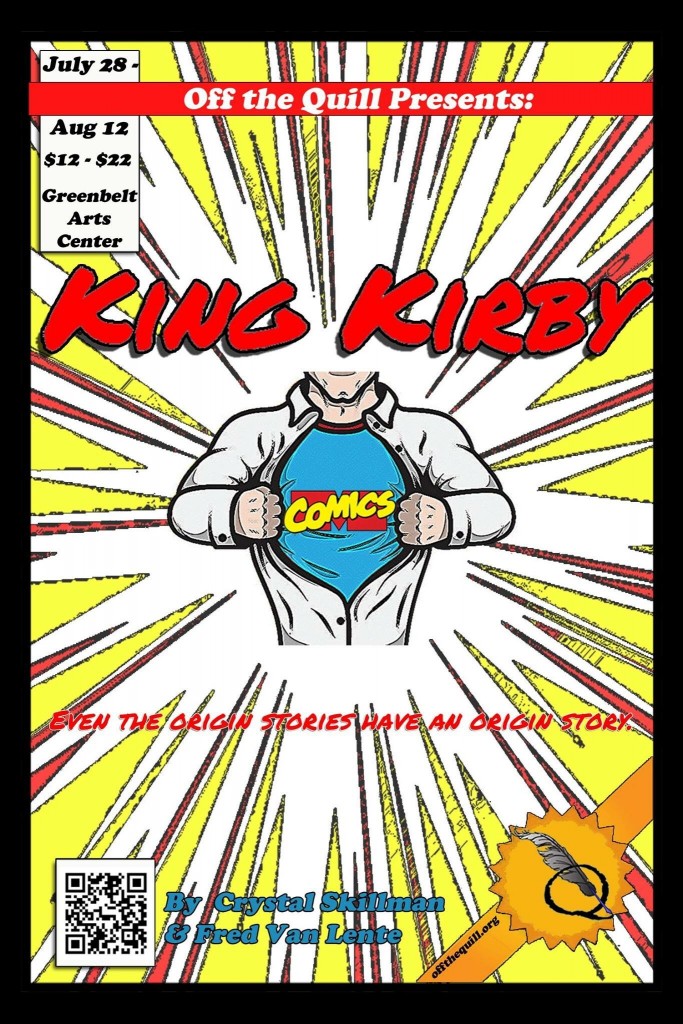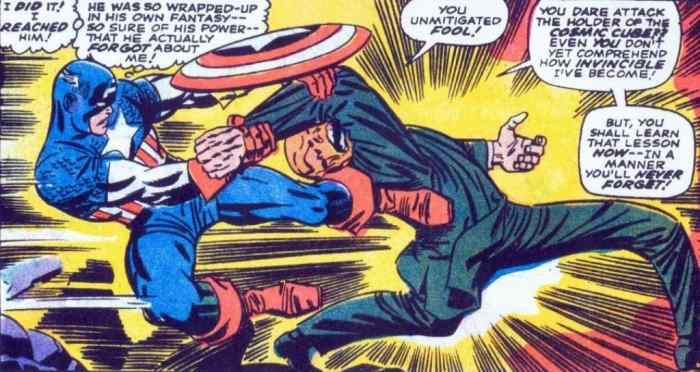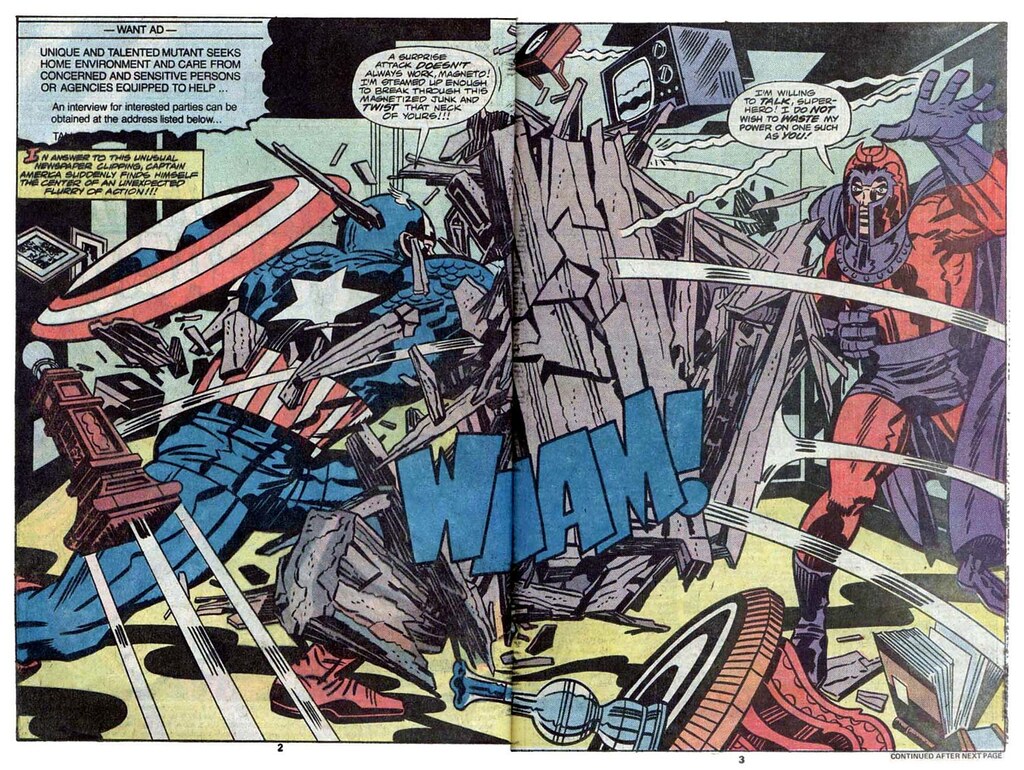
By Mike Rhode
Tonight a recent biographical play about comic book creator Jack Kirby will open for a three weekend run in Greenbelt, MD. Coincidentally, this is also the 100th anniversary year of Kirby's birth, and if you're a comic book fan, or love superhero movies, you should lift a glass to Kirby, and go see this play to learn more about him.
In 2014, comic book writer Fred Van Lente and his wife Crystal Skillman had a Kickstarter campaign to fund a staging of their “King Kirby” script. At the time, they described the project as:
KING KIRBY is a play by the husband-and-wife team of New York Times bestselling comics writer Fred Van Lente and NYIT award-winning playwright Crystal Skillman about the life and times of Jack Kirby, the great comic book artist who created or co-created some of your favorite heroes on the page and screen, Captain America, the Avengers, Thor, Fantastic Four, the X-Men, Iron Man, Young Romance, the New Gods, Darkseid, The Demon… the list goes on and on.
From the Jewish ghetto of New York's Lower East Side to the battlefields of France to the Senate hearings of 1950s, this is a hysterical and heartbreaking story about a man who pours his quintessentially Twentieth Century life into his comics, only to make the fateful mistake that sends him into obscurity while his creations become known to every person on Earth.
 |
| Original 2014 production art by Ryan Dunlavey |
King Kirby has been a long-term passion project of Fred's; with Crystal's help, it's down on paper. Now, with your help, we'll bring this astounding true story to life on stage.
The play has been staged several times (in Seattle and NYC) and is now coming to Greenbelt, MD via Off the Quill and William Keith Cassidy’s vision. A few days before the premiere, I talked to Cassidy (who was my daughter’s high school theater teacher and is a friend of mine) about some specifics of his staging.
Mike Rhode: When you cast Lee and Kirby, did you look at their real-life counterparts? Was that an issue for you?
 | ||
| Rehearsal shot of Josh Mooney as Jack Kirby and Erik Harrison as Stan Lee |
William Keith Cassidy: The nature of the play, and especially our production, is very theatrical so I didn’t feel I had to. Also, everyone, and especially Kirby himself, ages several years in the show. Kirby is on stage the whole time so there can be no makeup. It has to be done with acting. We have people in the cast playing four or five parts each, so I didn’t feel that I needed to find people that looked or sounded like them. With the exception of Stan Lee, because he’s the most recognizable. Erik Harrison had the look, and if you read his blog post, he talks about how he always came back to a smile, a grin and this vibrant, youthful energy that Stan Lee has. The one thing I did want physically is that I did want Jack Kirby and his wife Roz to be somewhat the same age. They look like they belong together. I cast a Jack and Roz who are both relatively young, but I could have cast them as older people. I didn’t want to cast one as really young and the other as really old; then they don’t look like they belong together. Whatever their aging is, they have to go together. The play all these lines about Kirby being short, but the actor isn’t and he has blond hair. I told him the other night, “I know you don’t look a thing like him, but by adapting his mannerisms, I think you look like Jack Kirby.”
 MR: I have not read this play, so what time frame in Kirby and Lee’s lives is it set? Is it set at the start of the Marvel Age?
MR: I have not read this play, so what time frame in Kirby and Lee’s lives is it set? Is it set at the start of the Marvel Age?WKC: It’s pretty much Kirby’s whole life. It actually opens after he’s dead and there’s an auction of his work and Kirby is commenting on it as an ethereal figure. Then it immediately flashes back to him as a kid in the street gangs in New York City. It goes through his life. We don’t even get to Marvel until the last third of the play.
MR: How long does the play run then?
WKC: There’s no intermission and it’s about an hour and thirty-five minutes.
MR: So that’s a lot of work for Josh Mooney who’s playing Kirby…
WKC: Yes. There’s one scene between where he’s working for Max Fleischer and then going to work for Victor Fox, where he leaves the set. It’s the only time he leaves the stage. For four minutes, he’s not on stage.
MR: Are there any other comic book people in it?
WKC: Joe Simon is a major character. The original production had Kirby and then only four other people. The actress who played Roz played all the females. The actor that played Simon played a bunch of people. I thought there were certain characters that were important enough to Jack’s life and recurred often enough to be their own actor. I didn’t want them to be ensemble people. My Simon, Lee and Roz - those are the only roles they play.
MR: So this is a deep dive into comics for an average person – how much did you have to work to convince the theater that it would draw a wider audience?
WKC: I didn’t have to work that hard, actually. There was only one theater I wanted to take this to – Off the Quill. I knew some people there and we’d done some shows together. I’d seen a lot of their shows. Like I said, I wanted to have a very theatrical, stylized element and this theater is very good at that. My assistant director Patrick Mullen really handled all the staging, the transitions, and the movement pieces. He was the mover and shaker behind the stylized pieces, but I don’t think you have to have a strong knowledge of comic books. The more you know, the more you’ll appreciate it, but you can come in knowing nothing.
MR: I saw David Bar Katz's The History of Invulnerability about Superman creators Siegel and Shuster at the Washington DC Jewish Community Center years ago, and you didn’t necessarily have to be steeped in comics.
WKC: Right. There were things I didn’t know about Kirby. I didn’t know that he and Joe Simon pretty much created the romance comic books. That was something I learned coming into this.
MR: Is Kirby’s New York background a major part of his character?
WKC: Yes. I don’t know much he felt this at the time he did it, or if it was later while looking back, but the play includes his regret that he changed his name to Jack Kirby from Jacob Kurtzberg, because he was very proud of his Jewish heritage and background. I don’t think he wanted to be perceived as someone who was trying to hide that. There’s actually a dream sequence at the end where he and Stan Lee are in a confrontation. The playwrights use the dream sequence to have a scene where Jack can say all the things to Stan that maybe he never said. One of the things Stan says is, “C’mon, you were ashamed,” and Kirby replies that he wasn’t ashamed.
MR: Everybody who was Jewish in comic books at the time changed their name. It would be hard to find someone who didn’t.
 WKC: There’s a funny scene where Stan Lee is a young kid and he’s writing the prose story in Captain America Comics (which was mandatory for cheaper postage rates), and Joe Simon says, “Who’s Stan Lee?” Lee says “That’s me, I changed my name just like Jack.” Jack says, “I changed my name to sound less Jewish ,” and Joe Simon tells Lee that his name sounds Chinese and he’s changed one minority for another.
WKC: There’s a funny scene where Stan Lee is a young kid and he’s writing the prose story in Captain America Comics (which was mandatory for cheaper postage rates), and Joe Simon says, “Who’s Stan Lee?” Lee says “That’s me, I changed my name just like Jack.” Jack says, “I changed my name to sound less Jewish ,” and Joe Simon tells Lee that his name sounds Chinese and he’s changed one minority for another.MR: When did you start working on this?
WKC: We had several meetings in the spring and we had auditions a week or two later. So in April, but we really got into it in May.
MR: Does the scenery have any fantastic elements?
WKC: It’s very open. We’re using projectors because I really want to create the idea that everything’s a comic book page. The projections are serving a lot of purposes. They’re showing his artwork, which is number one for me. When I read the play, it seemed the purpose of the play was to let everyone know what his contributions were, so the art had to be center. There are several scenes where there’s a transition from one time to another – it goes from 1961 to 1969, so we’re going to project and show all the Marvel characters he created. We have him drawing, and all the work around him on the walls and floors. We have two projectors on the walls, and one on the floor. We also wanted to use the projectors to show time and place as we cover a sixty-year span, and we use the projectors to show how his life influenced his art. There’s one scene during a street gang fight where they freeze, and it merges into a later Jack Kirby panel with a Viking battle scene that works really well. The theater is a black box with the audience ¾ of the way around the stage.
MR: You’ve cast your son, Brett Cassidy, in the play?
WKC: He’s young, but he reads a lot older on stage. He’s nineteen years old and he’s 6’ 7”. He’s playing most of the bosses. He plays Victor Fox, Martin Goodman, General Patton… he’s playing all the characters that are intimidating.
 MR: Whether it was true or not in the real world, Kirby apparently always felt put upon by anybody he worked for, and that comes through in the play?
MR: Whether it was true or not in the real world, Kirby apparently always felt put upon by anybody he worked for, and that comes through in the play?WKC: Oh, yeah. It’s one of the main themes. It’s one of the things that I responded to personally. Kirby had no problem fighting in a street gang, or fighting in the Army in France, but tried to avoid personal conflict. He’s also a product of the Depression and he doesn’t want to hurt his job. Stability is important to him.
MR: Does the play cover his DC years [when he created The Fourth World and the New Gods]?
WKC: No, when he leaves Marvel, the play skips 20 years. The way we’re staging it, we’re doing a transition and will see the DC years through the artwork projections, but it really picks up again in 1982.
MR: The court case against Marvel about Howard the Duck ownership that eventually led indirectly to the return of his original art?
WKC: Yes, he’s at a convention and he realizes someone is selling his original art. That leads into the dream sequence with Stan Lee. We just know he leaves because he’ll get full credit at DC and not argue with Stan Lee over who did what. The lack of financial rewards is touched on too. He’s at this convention and a fan asks him to sign original art, and Kirby asks how he got it. He also asks the fan about his New Gods for DC, and the fan says he couldn’t get into it.
MR: One of my academic friends, Charles Hatfield, has written a book arguing that the New Gods are Kirby’s true vision. And for the new Justice League movie, at least one of Kirby’s characters is a villain, and the New Gods might be the background for the whole Justice League film series… hopefully Kirby’s is getting some of the profits.
WKC: I hope so. I love [local author] Marc Tyler Nobleman’s movie “Batman and Bill” about Bill Finger’s role in Batman. I didn’t know his story at all.
MR: It’s interesting that comic book history is now focusing on creators instead of just the characters. I hope you are catching a wave.
WKC: I think so. Anybody that likes good theater will like it. Anybody that likes comic books will like it. We’ve got two good built-in audiences. It’s a great cast.
The play opens July 28th at the Greenbelt Art Center. Tickets are $22 or less.
For more information about the genesis of the play, read these two articles -
‘King Kirby’ Takes The Stage: Fred Van Lente On His New Play About Jack Kirby’s Life [Interview]
by Patrick A. Reed, June 19, 2014
“It’s not created by a machine – it’s art created by people” – An Interview with “King Kirby” Playwrights Crystal Skillman and Fred Van Lente.
by Reid Vanier, June 19, 2014










